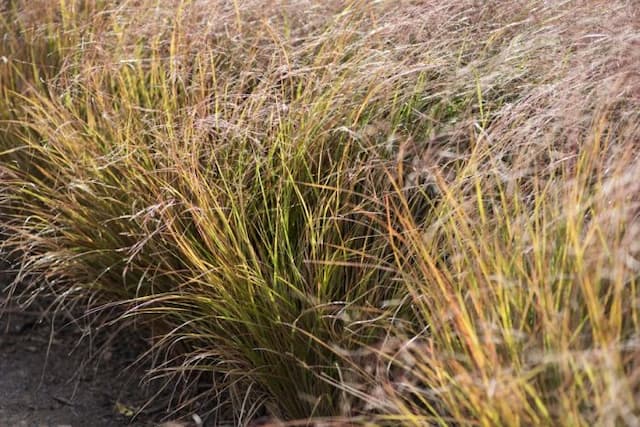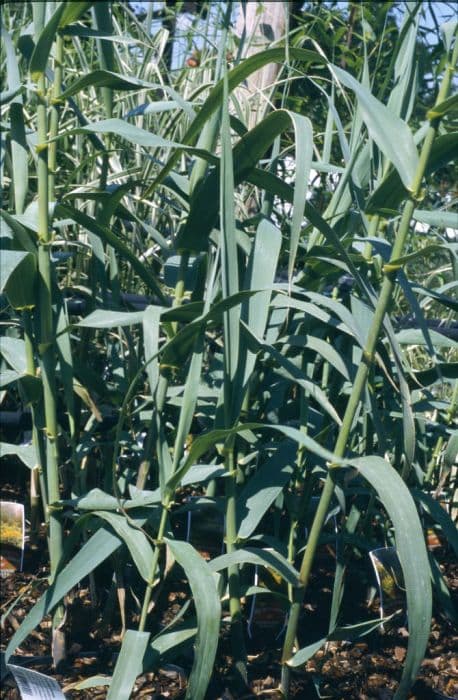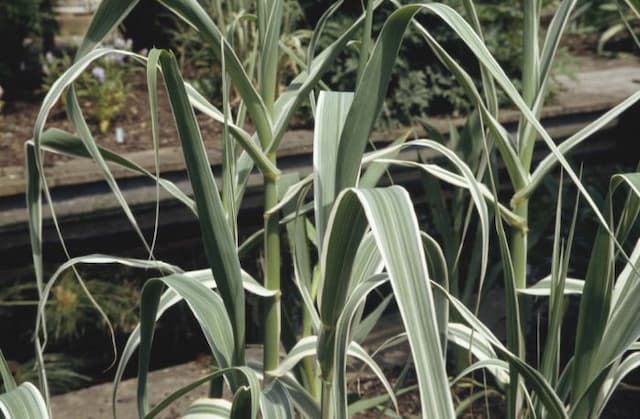Dwarf Greenstripe Bamboo Pleioblastus viridistriatus

ABOUT
The plant known commonly as the Dwarf Greenstripe bamboo is a visually striking plant characterized by its vibrant green leaves that are decorated with cream or pale yellow striping. This striping pattern gives each leaf a unique appearance, contributing to the plant's overall aesthetic appeal. The leaves have a narrow and elongated shape, tapering off to a point at the end, which creates a delicate and slender look. The Dwarf Greenstripe bamboo produces canes that are green when young, which may eventually turn into a yellow-green with maturity. This plant typically exhibits a dense, clumping growth habit, forming tufts of foliage that contribute to its lush, ornamental appearance. It is often prized for its colorful leaves and compact nature, making it a popular choice for a garden accent or as part of a mixed border to add contrast and interest.
About this plant
 Names
NamesFamily
Poaceae
Synonyms
Dwarf Greenstripe Bamboo, Greenstripe Bamboo, Kamuro-zasa
Common names
Arundinaria viridistriata, Pleioblastus chino 'Viridistriatus'.
 Toxicity
ToxicityTo humans
The common name for Pleioblastus viridistriatus is Dwarf Greenstripe Bamboo. Dwarf Greenstripe Bamboo is not commonly known for being poisonous to humans. There is no significant evidence to suggest that this bamboo species has any toxicity for people. Therefore, ingestion is not typically associated with any symptoms of poisoning or adverse health consequences in humans.
To pets
Known as Dwarf Greenstripe Bamboo, Pleioblastus viridistriatus itself is not specifically listed as toxic to pets. It is generally not considered poisonous to cats or dogs. This means that there are no well-documented symptoms of poisoning or severe consequences associated with pets ingesting parts of this bamboo plant. However, as with any plant material, ingestion can sometimes cause mild stomach upset in pets due to the fiber content.
 Characteristics
CharacteristicsLife cycle
Perennials
Foliage type
Evergreen
Color of leaves
Variegated
Height
4-6 feet (1.2-1.8 meters)
Spread
2-3 feet (0.6-0.9 meters)
Plant type
Shrub
Hardiness zones
5
Native area
Japan
Benefits
 General Benefits
General Benefits- Landscape Aesthetics: Pleioblastus viridistriatus, commonly known as Dwarf greenstripe bamboo, adds a unique visual appeal to gardens with its striking green and yellow-striped leaves.
- Erosion Control: Its root system helps to prevent soil erosion, making it useful for stabilizing banks and slopes.
- Low Maintenance: Dwarf greenstripe bamboo requires minimal care once established, making it a convenient choice for gardeners of all levels.
- Fast Growth: This bamboo species grows quickly, providing a rapid green cover and filling in garden spaces efficiently.
- Privacy Screen: It can be planted in a row to create a dense, fast-growing privacy screen or living fence.
- Wildlife Habitat: The plant provides shelter and food for various species of birds and insects, thus promoting local biodiversity.
- Noise Barrier: The dense foliage of Dwarf greenstripe bamboo can help reduce noise pollution by absorbing and deflecting sound.
- Ornamental Craft: Its canes may be used for crafting and can be a source of materials for garden stakes and other ornamental features.
- Culinary Use: Although not a primary use, some bamboo shoots, including those of Pleioblastus species, may be edible when properly prepared.
 Medical Properties
Medical Properties- This plant is not used for medical purposes.
 Air-purifying Qualities
Air-purifying QualitiesThis plant is not specifically known for air purifying qualities.
 Other Uses
Other Uses- Pleioblastus viridistriatus, commonly known as Dwarf Greenstripe, can be used to create musical instruments such as flutes due to its hollow stems.
- The fibrous nature of the Dwarf Greenstripe's stalks allows them to be processed into paper, offering an alternative to traditional wood pulp.
- In many parts of the world, Dwarf Greenstripe is cultivated as an ornamental plant, adding a touch of elegance to landscape designs with its striped foliage.
- Dwarf Greenstripe can serve as a natural privacy screen or living fence due to its dense growth habit.
- The strong, flexible canes of Dwarf Greenstripe are often used in furniture making, particularly for creating lightweight, sustainable pieces.
- Culms from Dwarf Greenstripe bamboo can be used in the construction of lightweight bicycle frames, offering a renewable material with good shock absorption.
- Dwarf Greenstripe is utilized in crafts and art for making bamboo wind chimes, which produce a unique and pleasant sound when the wind blows.
- The plant is also suitable for creating bamboo charcoal, which has various uses such as deodorization and moisture absorption in households.
- In some regions, Dwarf Greenstripe is adopted as a fodder crop for livestock, providing an additional food source due to its rapid growth.
- The aesthetic appeal of the Dwarf Greenstripe's variegated leaves makes it a popular choice for creating indoor arrangements and potted displays.
Interesting Facts
 Feng Shui
Feng ShuiThe Dwarf Whitestripe bamboo can be placed in the home or office to bring a sense of balance and positive energy, as bamboo is commonly associated with growth and adaptability in Feng Shui practice.
 Zodiac Sign Compitability
Zodiac Sign CompitabilityThe Dwarf Whitestripe bamboo is not used in astrology practice.
 Plant Symbolism
Plant Symbolism- Resilience: Pleioblastus viridistriatus, commonly known as Dwarf Greenstripe Bamboo, is known for its strong and flexible nature, symbolic of an individual's ability to withstand tough conditions and adapt to change.
- Growth: As a fast-growing plant, Dwarf Greenstripe Bamboo represents rapid growth and progress, encouraging one to always push forward and grow in life’s various aspects.
- Good Fortune: In many cultures, bamboo is seen as a symbol of good fortune and prosperity, and Dwarf Greenstripe Bamboo inherits this symbolic meaning, often used in homes and gardens to attract positive energy.
- Simplicity: The Dwarf Greenstripe Bamboo's simple and unpretentious form embodies the aesthetic of simplicity and elegance, conveying the idea that beauty lies in the simple things of life.
- Flexibility: Due to its ability to bend without snapping, this bamboo variant echoes the importance of flexibility in life, teaching us to bend in adversity without breaking.
 Water
WaterThe Dwarf Greenstripe Bamboo should be watered regularly to maintain a consistent level of moisture in the soil, especially during its growing season in spring and summer. Aim to water this plant once every week, but adjust the frequency depending on weather conditions and soil moisture levels—less often during cooler, wet months and more frequently in hot, dry periods. When watering, thoroughly soak the soil with approximately one to two gallons of water, ensuring that the water penetrates deeply to reach the roots. Avoid letting the bamboo sit in waterlogged soil, as this can lead to root rot.
 Light
LightDwarf Greenstripe Bamboo thrives in partial shade to full sun conditions. It prefers a spot that receives morning sunlight and afternoon shade, or dappled sunlight throughout the day. Avoid placing it in deep shade, as this can lead to a lack of vigor and sparse foliage, but also be cautious of exposing it to harsh, direct afternoon sun which can scorch the leaves.
 Temperature
TemperatureDwarf Greenstripe Bamboo does well in a wide range of temperatures but prefers a range between 50°F and 90°F for optimal growth. It can tolerate a minimum temperature of around 0°F but should be protected from prolonged exposure to freezing conditions. Ideal growth occurs when the temperature is consistently mild to warm.
 Pruning
PruningDwarf Greenstripe Bamboo benefits from occasional pruning to maintain its shape and encourage healthy growth. Prune in the late winter or early spring before the onset of new growth by cutting back any overly long or untidy canes. Thin out dense clumps every 2-3 years to allow light and air to reach the inner parts of the plant, promoting overall plant health.
 Cleaning
CleaningAs needed
 Soil
SoilThe best soil mix for the Dwarf Greenstripe Bamboo should be rich, well-draining, and able to retain moisture. A mix of loam, compost, and sand can be ideal, with a slightly acidic to neutral pH, around 6.0 to 7.0.
 Repotting
RepottingDwarf Greenstripe Bamboo should be repotted every two to three years or when it outgrows its container, to refresh the soil and manage its growth.
 Humidity & Misting
Humidity & MistingDwarf Greenstripe Bamboo thrives in moderate to high humidity levels, ideally between 40% to 60%.
 Suitable locations
Suitable locationsIndoor
Place Dwarf Greenstripe Bamboo in bright, indirect light and keep the soil moist.
Outdoor
Plant Dwarf Greenstripe Bamboo in partial shade; water regularly.
Hardiness zone
6-10 USDA
 Life cycle
Life cyclePleioblastus viridistriatus, commonly known as Dwarf Greenstripe Bamboo, begins its life cycle as a rhizome underground. This rhizome eventually sprouts into a shoot that grows rapidly, reaching its full height within a single growing season, as bamboo exhibits a unique fast-growth characteristic. The culms (stems) then harden and mature, developing the distinctive green and yellow-striped patterning that gives the common name to this bamboo. In maturity, the plant produces narrow leaves and can also flower, although flowering is rare and bamboo plants typically flower only once in their lifetime before dying. After flowering, seeds may be produced, which can disperse and begin new rhizomes, although vegetative propagation through rhizome division is more typical for expanding a stand of Dwarf Greenstripe Bamboo. The adult bamboo can live for several years before the entire grove reaches the flowering stage, after which the cycle may begin anew from seeds or continue through the spreading of rhizomes.
 Propogation
PropogationPropogation time
Spring-early summer
Propogation: Pleioblastus viridistriatus, commonly known as Dwarf Greenstripe bamboo, is best propagated in the late spring to early summer when the plant's growth is most active. The most popular method of propagation for Dwarf Greenstripe bamboo is by division. To do so, you simply divide the plant's clumps, ensuring that each new section has its share of roots. Carefully dig up a clump of the bamboo and shake or rinse off the soil to reveal the rhizomes and roots. Using a sharp, clean cutting tool, separate the clump into smaller sections, making certain each division has at least one healthy growth shoot or culm and a good root system. After division, the new plants should be immediately replanted in a well-draining soil mix and watered thoroughly. This method is effective because it is a quick way to produce new plants that are exact replicas of the parent.









